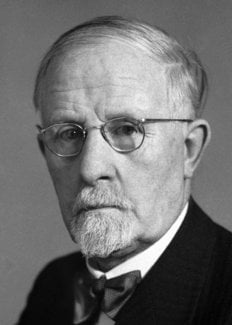Walter Hess
Biographical

Walter Rudolf Hess was born in Frauenfeld, East Switzerland, on March 17, 1881. His father was a teacher of physics who allowed him, at a very early age, great freedom in dealing with apparatus, and taught him a proper carefulness. He also obtained a self-reliant gift of observation during excursions through forests and meadows, and on lakes and rivers, in the environment of the town of his birth. Here, he also visited the Gymnasium, completing the course in 1900. As a medical student, he visited Lausanne, Berne, Berlin, Kiel, and Zurich. In the University of the latter town he took his degree of Doctor of Medicine in 1906.
Although his aim always was to be a physiologist, external reasons first necessitated him to be an assistant in surgery, later in ophthalmology, and finally a practising opthalmologist. This detour, however, was by no means a disadvantage, as he learned, particularly in ophthalmology, to investigate and operate with precision. Also the contact with pathological physiology has proved in many respects a positive advantage.
In 1912 he took the great decision – although already the father of a family – of leaving a prosperous practice and going back to the position of assistant, this time in physiology itself. He obtained his training from Professor Gaule, a pupil of Ludwig, and from Professor Verworn in Bonn. In 1917 he was nominated – not without great opposition – Director of the Physiological Institute at Zurich, with corresponding teaching responsibilities. After the First World War, he visited many English institutes and got to know the English doyens of physiology such as Langley, Sherrington, Starling, Hopkins, Dale, and others.
The scientific interests of Professor Hess were primarily directed towards haemodynamics and, in connection with this, the regulation of respiration. While the experimental work on the subject of the central coordination of vegetative organs has in general been extended, a comprehensive picture has emerged of the representation of the vegetative nervous system in the diencephalon, which has been accorded distinction by the Nobel Prize.
During the experimental investigations of the diencephalon, setting aside the evidence of the regulatory representations, which control the activity of the internal organs in a coordinated fashion, somatomotor effects were observed relatively often. Following this, the symptoms were analysed in more detail, and in the process a relationship was demonstrated between supporting functions, automatic correcting movements, and the differentiated maintenance of tone in the skeletal musculature, as also were connections with actions due to the vestibular apparatus. Other investigations dealt with the control of parts of the forebrain (area orbitalis), in which Hess together with K. Akert has achieved some insight into the cortical representation of sight, and oral and pharyngeal regions.
When the professorship and the directorship of the Physiological Institute had to be given up in accordance with the regulations, Hess had the right to transfer all the material which had been acquired over the previous years to the rooms placed at his disposal in the Physiological Institute. The possibility also existed here of allocating a workplace; to co-workers, and of using the «cerebro-biological collection», which he had built up, for research purposes. So the work went on, albeit restricted in terms of space, and above all of staff.
It had already occurred earlier to Hess that in the experiments on diencephalic stimulation modes of behaviour were occasionally evident in the experimental animal, which suggested a manifestation of psychic powers. Thus was the theme of The Biological Aspect of Psychology (1962) established; this was taken up, after the fundamental findings on stimulation or extirpation at defined sites in the diencephalon had previously been described in an atlas (1956).
Out of this work on the integration of the experimental material in question concerning psychologically motivated expressions of the functional organization of the brain, among other things a contribution has been brought about towards bridging the gap which, until then, had yawned between physiology and psychiatry. At the same time in the monograph where his findings were summarized, the physiological foundations of the clinically important study of psychosomatic phenomena were dealt with, and the understanding of the mode of action of the so-called psychotropic drugs was advanced. Also, certain guiding principles for a closer contact between the investigation of behaviour and the type-specific organization of the central nervous system were included.
In the course of the last few years, the goal of satisfying the prerequisites for continuing and broadening research on the brain was finally pursued.
As the result of combined efforts, a special professorship for research on the brain with an independent institute at the University of Zurich has been established, of which his former co-worker, Professor K. Akert, has been elected director.
This autobiography/biography was written at the time of the award and first published in the book series Les Prix Nobel. It was later edited and republished in Nobel Lectures. To cite this document, always state the source as shown above.
Walter Hess died on August 12, 1973.
Nobel Prizes and laureates
Six prizes were awarded for achievements that have conferred the greatest benefit to humankind. The 12 laureates' work and discoveries range from proteins' structures and machine learning to fighting for a world free of nuclear weapons.
See them all presented here.
